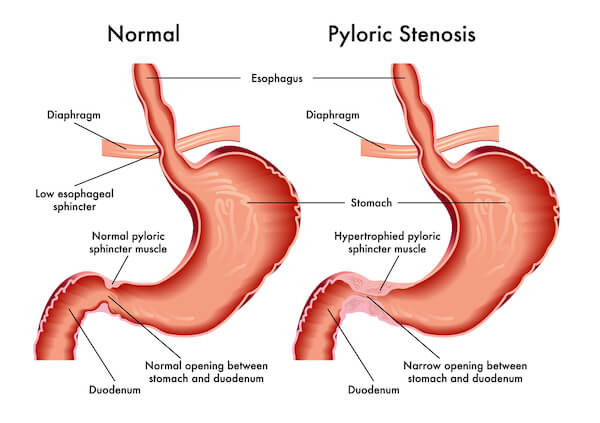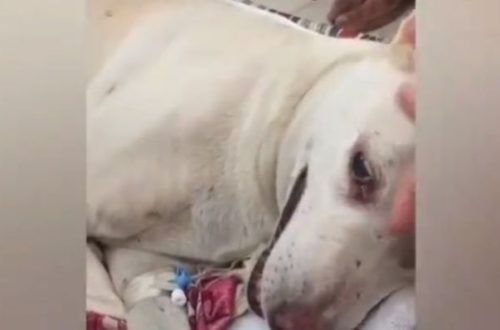
Pyloric stenosis in a dog: what is pyloric stenosis and how to get rid of it
Pyloric stenosis is also called pyloric stenosis in dogs. It is also known as pyloric hypertrophy syndrome or increased muscle tissue. The disease is a narrowing of the part of the stomach called the pylorus. The pylorus is a valve-like opening through which food leaves the stomach and enters the intestines.
In medical terms, “stenosis” means “narrowing.” The work of the pylorus is controlled by the muscles surrounding it, and when they thicken, they cease to function properly. This causes the opening to close completely or partially, preventing food from exiting the stomach normally.
Contents
Causes of pyloric stenosis in dogs
The appearance of the syndrome can provoke congenital selective thickening of the smooth muscles of the pylorus. In dogs born with pyloric stenosis, characteristic signs usually appear some time after weaning and transition to solid food. This usually happens between the ages of 4 and 12 months.
Another reason may be related to the gradual thickening of the smooth muscle or gastric mucosa. The cause of this form of the disease is unknown. In dogs with this form of pyloric stenosis, the first symptoms usually appear in middle or old age.
Brachycephalic, or short-nosed, breeds, including boston—terriers, boxers and bulldogs are more predisposed to congenital pyloric stenosis. Small breed dogs, including Lhasaabso, Shea—tsu, Pekingese and MalteseBolognesemay be at greater risk of developing an acquired form of pyloric stenosis.
Symptoms of pyloric stenosis in dogs
The most common sign of pyloric stenosis in dogs is the dog’s chronic vomiting after meals in short bursts. This is a dynamic process in which the pet, using the abdominal muscles, regurgitates the contents of the digestive tract, which appear to be overcooked. The pet can also vomit with a fountain.
With a congenital form of pyloric stenosis, vomiting attacks in a dog after eating begin in a puppy after weaning and switching to solid food. Other potential clinical signs associated with pyloric stenosis in dogs include:
- Regurgitation. Passive expulsion of the contents of the digestive tract, in which the dog burps the undigested contents of the stomach.
- Decreased appetite.
- Weight loss.
- Dehydration.
- respiratory problems, e.g. aspiration pneumonia on the background of vomiting. Aspiration occurs when a foreign substance is accidentally introduced into the lungs or airways. In this case, vomiting can lead to a lung or respiratory tract infection, which in turn can lead to pneumonia.
These symptoms are related to the degree of pyloric thickening and usually do not improve with drug treatment of the symptoms. If your pet exhibits any of these symptoms, further evaluation by a veterinarian is necessary.
Diagnosis of gatekeeper stenosis
Because chronic vomiting can have many potential causes, diagnostic testing is necessary. Usually a complete blood count (CBC), a biochemical blood test and a urinalysis, as well as an x-ray of the abdomen are required.
In many cases, blood and urine tests will be normal or may show mild dehydration or an imbalance in electrolytes, important minerals needed for basic bodily functions. However, even if the blood test is normal, it can help rule out other causes of vomiting.
In the case of an obstruction at the level of the pylorus, an abdominal x-ray may show accumulation of fluid in the stomach, which leads to bloating. A chest x-ray is ordered in the presence of any associated respiratory problems to evaluate for aspiration pneumonia or other chest abnormalities.
If pyloric stenosis is suspected, additional x-rays of the abdomen are often taken after oral administration of a barium contrast agent. It helps the veterinarian to better visualize the abdominal cavity.
Delayed gastric emptying and narrowing of the pylorus may also indicate a diagnosis of pyloric stenosis. If possible, a follow-up x-ray, called a fluoroscopy, or an abdominal ultrasound to evaluate for the presence of pyloric stenosis should be taken before more invasive diagnostic tests.
If you suspect pyloric stenosis in a pet, you can also use a camera to examine it. In addition, endoscopy may be performed to obtain samples of pyloric tissue for biopsy. Biopsy is important to rule out other causes of thickening of the pyloric tissue.
In some cases, exploratory surgery is necessary to make a definitive diagnosis.
Individual course of treatment
Treatment for pyloric stenosis in dogs usually involves surgery, as it results in gastric obstruction in most cases. The most common operation is a procedure called pyloroplasty. It allows you to remove the thickened tissue of the mucous membrane of the pylorus and expand the pylorus at the exit site of food from the stomach. In some advanced cases, more complex surgery may be required to remove the affected pylorus.
In the absence of post-operative complications, most dogs undergoing surgery to treat pyloric stenosis do well and can return to their normal lifestyle.
See also:
- How to help a dog with a sensitive stomach?
- How to treat an upset stomach in a dog
- Gastrointestinal pathologies and indigestion in dogs: types and causes
- How do you know if your dog is in pain?





